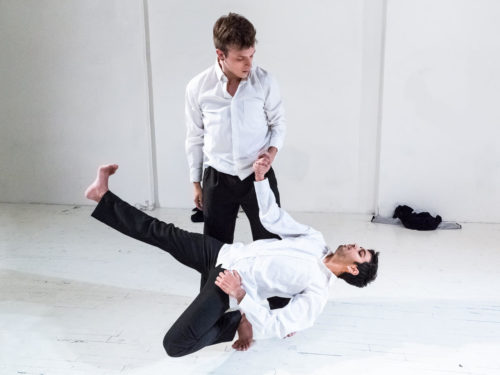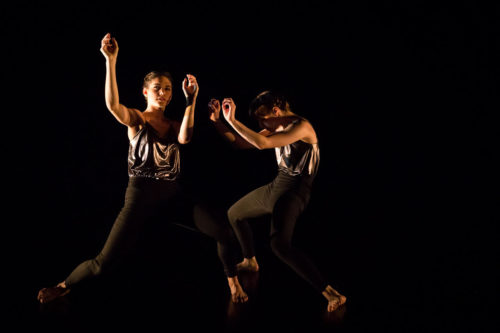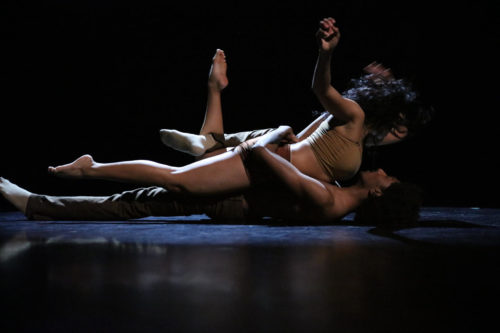The Dance Gallery Festival/Texas Experience: Offering a Taste of the Trajectory of Contemporary Choreography in New York and Texas

Rovaco Dance Company / Rohan Bhargava -Ezra Goh Photography
For two nights at the Gaertner Performing Arts Center Dance Theater at Sam Houston State University (SHSU), audiences partook of ten pieces by ten different artists chosen from over 300 submissions, reflecting a tightly woven network between Huntsville, Texas, and New York City. The duet-heavy show offered a progressive dance dinner to the nearly-full house, through which we enjoyed enough samplings to whet one’s dance appetite.
Autumn Eckman’s delightful duet “Chicken Scratch” opened the evening. The pair performed stylized play, complete with leap-frog and ear-pulling to the Barry Sisters’ 1962 version of the Yiddish children’s song “Chiribim Chiribom.” Each interaction proved direct; each look precise and purposeful. Dancers JaVonté Carney and Eduardo Zambrana (from the University of Arizona School of Dance) delivered the short work cleanly and with pluck.
In “Her Fragile Silence” Texas-based choreographer Jennifer Mabus presented a poignant duet danced by Paige White and Dwain Travis, both of Houston’s METdance. A motif of slow backward bending anchored the choreography. Continual exchanges of these seemingly indefinite hinges evoked trust and the tenderness of a supportive relationship. The music, an original composition by Brittany Padilla, lifted the movement, buoying but never overpowering it.
Andre Drummond’s “Of The World” began with a series of spoken phrases set against a strobe spot that allowed us only glimpses the moving body — an amazingly articulate body down to each finger, which he balanced with equally impressive fluidity and extensions. The lighting shifted to a broad center spot that illuminated the bareness of the stage and of Drummond himself, presumably the self present in and presented to the “world” of the title.

Bombshell Dance Project – Photo by Lynn Lane
Dallas-based Bombshell Dance Project’s “Meant To Be Seen” commanded attention through expansive movement and use of space accompanied by the mid-twentieth-century icons Audrey Hepburn and Marilyn Monroe. Dancers/choreographers Emily Bernet and Taylor Rodman challenged perceptions of the benefits of beauty most strikingly when they jumped up and down repeatedly while facing upstage to Monroe’s “generally miserable” reply to a reporter’s question about how she “generally” felt. Using the 20th Century Fox theme to close suggested that the pair has only just begun to reveal the many ways (and times) they merit being seen.
The Texas Experience of the Dance Gallery Festival struck gold in securing New York-based choreographer Sidra Bell as their guest artist-in-residence. Her “actors (in the flesh),” created in one week with 15 dancers, showcased the technical capabilities of SHSU students, as well as reified her status as one of the most cutting-edge choreographers working today. She deftly interwove solos and small groups within a cacophonous, but somehow not distracting, score. Her parade of bodies clad in sheer animal print tights, bra tops and leotards at times invoked Nijinsky’s Afternoon of a Faun, as the dancers traversed the stage slowly in two-dimensional poses reminiscent of Grecian urns. Some of the movement bordered on the grotesque, as dancers stretched beyond accepted mobility, revealing the constraints of the flesh to close the first half.
Following intermission, dancers Nico Gonzales and Alden Henderson enacted a touching vision of a journey to the marriage altar in New York choreographer Rohan Bhargava’s “The Wedding.” As the piece progressed, the dancers took notice of one another and reacted with a spirited exchange, capturing one another in quite impressive moments. For example, one dancer pitched backwards to the floor to balance on one foot as the other confidently held only one hand. I would like to see the piece again with greater attention to the costume; something trimmer to the bodies would further enliven both the choreography and the capabilities of Gonzales and Henderson.
Next, Bridget L. Moore conjured the catwalk in her duet “UNCHARTED TERRITORY.” Light projected onto a sliver of the upstage scrim, first white, then red, set the scene. Sculptural couture costumes designed by Fernando Hernandez proved the highlight, in particular a short skirt of concentric white rings that bounced and spun as Chaslen Osler strutted through center stage. Moore’s visually compelling piece drew on house dancing vocabulary, including allusions to “grandfather of voguing” Willi Ninja’s affinity for kung fu films.

Emily Robison. Photo by David Deveau
Emily Robison, a current SHSU student, then showed her choreographic promise in “Futile Attempts at Saving the Already Forgotten.” Dancers Ke’Ron Wilson and Kharma Grimes-Hardie exuded a sense of foreboding as they began with a slow revolution, fully displaying her tenuous grasp as he continually attempted to prop her back up. Grimes-Hardie admirably managed the balance between complete surrender and hanger-on; just when we believed her revived, she re-submitted herself to the status of “already forgotten.”
“Wally,” choreographed by New York artist Nicole von Arx and danced by von Arx and Michael Greenberg, demonstrated the symbiosis possible between two performers. Similar to Eckman’s duet, the pair frolicked together; however, composer and cellist Rob Lewis’s “Pines” canopied the piece as trees in the forest. The two smoothly transitioned between sneaking up on one another (only to switch places during blackouts) and impeccably executed synchronicity, leaving me hungry for more.
Joshua Peugh’s Dallas-based Dark Circles Contemporary Dance closed the night with selections from their full-length show Aladdin. According to the company’s press materials, the evening “is a meditation on American rhetoric regarding the Middle East and the stereotypes associated with Middle Eastern races and cultures.” I suspect that in order to fully appreciate the impact of Peugh’s work I need to view it in its entirety. Though clearly well-rehearsed and skillfully performed, in this festival format the (potentially welcome) challenge to the familiar story lacked its narrative arc.
The Dance Gallery Festival/Texas Experience succeeded in its aim to bring new artists to new audiences (and vice versa). I hope that the smörgåsbord gave the audience enough of a taste that they pursue full courses of these artists’ work. I especially applaud the efforts of festival founder and artistic director Astrid von Ussar to promote the exposure of collegiate artists to those already in the field through the relationship developed with Sam Houston State University, and I look forward to future offerings.



Recent Comments